Electric 4x4
Winter Package

Book a private transfer from Lyon Airport (LYS - Lyon Saint-Exupery) to Courchevel if you want to get to the ski resort at a relatively low price and without spending a lot of time on the road. If the transfer starts at the airport, then the transfer price is from 300€, the route distance is 178 km, and the travel time is about 3 hours. If you are leaving from the center of Lyon, the minimum price is 350€, the length of the road is about 198 km, which will take you about 3.5 hours. Transfer duration varies between 20 and 30 minutes, depending on which Courchevel station your hotel is located at.
The transfer price includes a 1 hour wait at the airport or a 20-minute wait at your hotel (after this, there is an additional charge of €60-80 per hour). You will also be provided with free child seats, drinking water, and Wi-Fi inside the car.
Transfer payment can be made in installments (a small deposit in advance and the remainder to the driver by card or cash) or in full in advance via bank transfer or card link.
We provide our clients with the driver's contact information and name one day before the transfer. They will meet you with a sign at the exit of the airport arrivals area. If the airport is crowded, you can contact them via WhatsApp to make it easier to find each other.
After the meeting, the driver will help you load your suitcases and skis and drive you pre-booked to your hotel in Courchevel. If you need to stop at a restaurant or shop along the way, please let us know in advance so the driver can reserve additional time for this. You can book a transfer from Lyon to Courchevel on our website, by email, or via WhatsApp. Bycar provides individual transfers 365 days a year at any time of the day.
Travelers from Lyon to Courchevel book a transfer or taxi from their hotel in central Lyon or from Lyon Saint-Exupéry Airport (LYS). It's important to understand that the airport is 34 km from the city, so travel times to Courchevel can be 30-50 minutes longer. Sometimes people don't take this into account when planning their trip and end up late for meetings or, conversely, arriving too early for their flight.

The route from Lyon Airport to Courchevel via Chambéry on the A43 motorway is the main and fastest way to reach your desired ski resort. The total route length is 187 km, and the travel time is between 2.5 and 3,5 hours (depending on traffic, which varies greatly depending on the influx of tourists in winter, especially on Saturdays and during school holidays).
You leave Lyon Airport and, after a short stretch, join the A43 highway, heading east. After 60 km, you pass Chambéry and continue on. After about 50 km, at Albertville, you turn right onto the N90, which takes you 25 km to the town of Moutiers. This is the last town on your route, located on a flat surface; after it, the road begins to wind. The road from Moutiers to Courchevel is not easy; it's winding and can be covered in snow. Because of this, traffic jams can be severe on this stretch, and the journey can take a considerable amount of time.
Courchevel's resorts are located at four altitudes, so the distance from Moutiers to your hotel and the time it takes to negotiate the switchbacks vary: to Courchevel 1300, Le Praz = 16 km (30-50 minutes); to Courchevel 1550, Village = 17 km (40-60 minutes); to Courchevel 1650, Moriond = 20 km (approximately 1 hour); to the highest Courchevel 1850 = 24 km (approximately 1.2 hours).

If your trip to Courchevel by taxi or transfer starts in Lyon city center (from your hotel or train station), the journey will take 3.5-4.5 hours (which is 30-50 minutes longer than if you travel from Saint-Exupéry Airport). The distance is approximately 198 km if your route passes through Chambéry. If you decide to drive through Grenoble by turning onto the A48, the route will be 241 km long and will take about 20 minutes longer.
| Route | Distance | Time | Tolls | Pros | Cons |
|---|---|---|---|---|---|
| From Lyon airport | 187 km | 2.5–3.5 h | €10–20 | The road is shorter | You won't see Lyon |
| From Lyon city | 198 km | 3.5–4.5 h | €20–40 | See a beautiful city | More time to travel |
 |
ByCAR has received the "Travelers' Choice 2025" award from Tripadvisor this year, which reflects the high quality of our services and our attentive approach to our clients. |
Our clients leave reviews on Tripadvisor about their transfers from Lyon city center or Lyon Airport to Courchevel. This experience helps you understand how your trip will go, how drivers behave, and which cars are best to book.
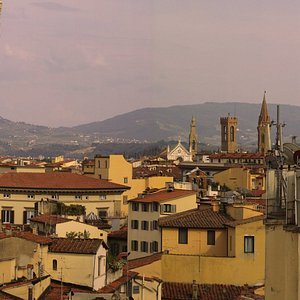 |
Andrei S. (Mar 2025)
This March, we took a V-Class car to Courchevel. It took us three hours from Lyon, but the journey went by unnoticed. The cars were very comfortable, and the driver was a pleasant and sweet young man. We stopped for coffee along the way. My children didn't get carsick because he drove very calmly and evenly, even on the winding roads. Thank you Alex and thank you Bycar!!
(read original review on Tripadvisor)
|
 |
Tour Company (Jan 2025)
Excellent service, good cars and experienced drivers. Managers quickly matched cars to rides. From us 2 families with whom vacationed left with bycar and were satisfied as we were. The best! We will use and recommend to friends
(read original review on Tripadvisor)
|
 |
Natalia C. (Jan 2025)
Undoubtedly the best company that organizes transfers to us for the third year to ski resorts in France, manager Alexandra is always in touch, the best service and inexpensive, the cars are always awake, the drivers are very pleasant ... everything was done as agreed ... we are always with you , thank you for the service !!️
(read original review on Tripadvisor)
|
 |
Bona (Feb 2024)
This February we went to Courchevel. We were driven there and back by a bycar driver. Thank him very much! He waited for us, although the plane was delayed by 1 hour. He helped with the suitcases. Next season we want to go with them again, but this time to Zermatt!
(read original review on Tripadvisor)
|
You can find out more information about the company ByCAR and about our work in social networks Facebook, X, LinkedIn, Instagram, Tripadvisor).
 |
 |
 |
 |
 |
| X | TripAdvisor |
The best price for a transfer from Lyon Airport (Lyon Saint-Exupery - LYS) to Courchevel = 300€ (per passenger car). If you need a van for 4-8 people like Renault Trafic, then the price on weekdays = 340€, on Saturday = 420€. Bycar also offers business and premium class transfers = 470€ (Mercedes V-Class).
At night (from 06:00 AM to 22:00 PM), a night rate with a higher price may apply. It's best to book your transfer several weeks in advance (or 2-3 months in advance during peak season) to ensure the best price for the most comfortable vehicle.
| Car class | Price |
|---|---|
| Electric 4x4 | 350€ |
| Economy | 300€ |
| Economy van (❗️business days) | 340€ |
| Comfort | 360€ |
| Comfort van | 420€ |
| Business | 425€ |
| Business van (❗️business days) | 430€ |
| Premium | 720€ |
| Premium van | 470€ |
The ByCAR transfer from Lyon Airport to Courchevel includes: airport pickup with a sign, 1 hour of free waiting time, toll roads, drinking water, and Wi-Fi. Our operator will notify you of the transfer price in advance, and it will not change unless you change your route or require additional waiting time.
The lowest transfer prices from Lyon to Courchevel are on weekdays. Book your car for travel Monday through Friday and you'll save big.
On Sunday, you can find a car cheaper than you would book for Saturday. However, transfer prices to Courchevel are lower during the week.
You can choose a car for your transfer from Lyon to Courchevel based on your comfort requirements, the size of your group, and the number of suitcases you have. For 2-3 passengers, there are sedans (Volkswagen Jetta) with compact trunks at affordable prices. For big groups of up to 6-8 passengers, book a van (Mercedes V-class or Renault Trafic); if you're traveling with a very large group, there's a Mercedes Sprinter with up to 20 seats.
The roads leading from Lyon to Courchevel are almost always clear: the plains are warm and there's rarely any snow, and in the mountains they're well-cleared and frequently. However, in heavy snowfall, you should always have snow chains on your car, and it's best to drive a four-wheel drive vehicle (Skoda Kodiaq или Mercedes V class 4matic) or at least one with high ground clearance.
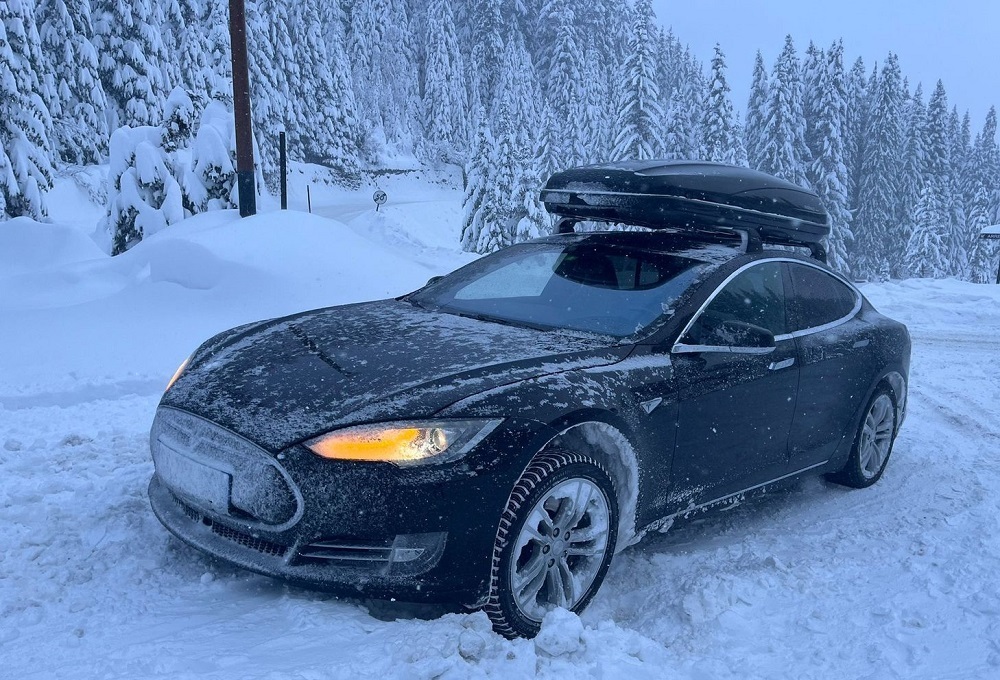





The transfer time to Courchevel from Lyon Airport is 2.5 - 3.5 hours, and from Lyon city center 3.5 - 4.5 hours. Travel time depends greatly on traffic and the amount of snow on the roads in the mountains. There are also some holidays or days coinciding with the beginning and end of children's school holidays, when traffic jams can be even worse and travel times reach their maximum values.
| Time/date | Min travel time |
|---|---|
| If your trip coincides with locals commuting to work in the morning or returning home in the evening, you could spend 30-50 minutes longer on a transfer or taxi. Therefore, it's best to avoid driving near Lyon and other major cities between 08:00 and 09:30 AM and between 17:00 and 18:30, or allow extra travel time. | 4.0 h |
| Saturdays are especially busy because most hotels and chalets only book from Saturday to Saturday. Consequently, almost all tourists arrive in Courchevel on Saturday and return a week or two later. Therefore, it's best to find accommodation with midweek check-in or at least Sunday check-in. | 4.5 h |
| Traffic jams on the route from Lyon to Courchevel increase greatly during the French school holidays, as adults can finally take their children on holiday to go skiing and snowboarding. Christmas holidays from 20.12.2025 to 05.01.2026. Winter holidays 07.02.2026 - 23.02.2025 (schools from zone A); 12.02.2026 - 03.03.2025 (schools from zone B); 21.02.2026 - 09.03.2025 (schools from zone C). Traffic jams are especially bad on Saturdays, which fall during these periods. | 5.0 h |
| The worst days for transfers are the last Saturday of the outgoing year (27.12.2025) and the first Saturday of the new year (03.01.2026). We strongly advise against choosing these dates for a trip to the mountains. You can spend 8-12 hours getting from Lyon Airport or from the center of Lyon to Courchevel. Some tourists fly in and stay overnight in a hotel near Lyon Airport, and then go to Courchevel the next day. It is also better to return from Courchevel to Lyon one day earlier or one day later. As a last resort, if you cannot change your travel dates, try to leave Lyon Airport on 27.12.2025 before 07:00 am (before traffic jams). And to return on 03.01.2026, you need to leave Courchevel at 03:00-04:00 am. | 8-10 h |
| You order a transfer on our website | |
| We send you a confirmation and contact details | |
| Our driver meets you at the airport arrival with a sign | |
| The driver takes you to your hotel or apartment in Courchevel | |
|
You make the balance payment to the driver |
A taxi from Lyon Airport to Courchevel takes approximately 3.5 - 4.5 hours and costs 450-800 euros depending on the type of car, the size of the luggage and traffic jams.
This is one of the fastest ways to get to Courchevel, but the price is much higher than the cost of a private transfer to Courchevel. Taxis wait for tourists near the airport exit, but during high season, especially on Saturdays, it can be difficult to find a suitable taxi.

Remember that taxi drivers rarely speak English well, mostly only their native French. Therefore, it is better to immediately prepare information about your destination. Provide the driver with your hotel name and address. It’s even better to show the geolocation on Google maps, because the addresses of many hotels and chalets in Courchevel are indicated without a house number, only the street name.
The taxis that you take at Lyon airport are suitable for a trip to Courchevel if there are not many of you (1-3 people) and if you have few bags and suitcases with you, skis will most likely fit if you are 2 passengers. Most taxis are cars; a van for 4-8 passengers is extremely difficult to find, especially on weekends or holidays. If you are traveling with your child, keep in mind that not all taxi cars will have a child seat (this happens very rarely), especially if you need a bassinet for the smallest babies.
The cost of a taxi is higher than the cost of a transfer and a rented car. How much you will pay for the trip from LYS to your hotel in Courchevel is almost impossible to say in advance. The price depends on the number of suitcases and skis, the size of the group, time and date of departure and traffic jams.
2.4€ per 1 km during the day (7am - 19pm), Monday to Friday
3.29€ per 1 km in the evening (19pm - 7am), as well as on weekends and holidays.
4.5€ for each suitcase, skis, snowboard and each passenger if more than 3 people
4.18€ for getting into a taxi
38.96€ for additional waiting
*prices are for sedans, prices for vans are much higher.
In order to understand approximately how much you will need to pay for a taxi to get to your hotel in Courchevel from Lyon airport, we will calculate two options for a typical trip.
The flight arrives on Wednesday 20.12.2023 at 11:05 am;
2 passengers; 2 suitcases L and 1 suitcase S; 1 backpack 1 skis;
The route distance is 186 km. Travel time 2.5 hours (without traffic jams)
Price calculation = 2.4€ * 186km + 4.5€ * (2+1+1+1) + 4.18€ = 473.08€ (for a passenger car)
The flight arrives on Saturday 01.06.2024 at 13:30 am;
3 pax; 2 suitcases L and 3 suitcases S; 2 backpacks 2 skis;
The route distance is 186 km. Travel time 4 hours (including no traffic jams)
Price calculation = 3.29€ * 186km + 4.5€ * (2+3+2+2) + 4.18€ + 38.96€ = 473.08€ (for a passenger car)
Using this table, you can compare the main pros and cons of taxis and transfers from Lyon to Courchevel and make your choice when planning your trip.
| Parameter | Taxi | Private Transfer |
|---|---|---|
| Average price | 450-1000 EUR | 300-470 EUR |
| Travel time | ~2h30 | ~2h30 |
| Fixed cost | ❌ No | ✅ Yes |
| English-speaking driver | ❌ Rare | ✅ Always |
| Luggage space | Limited | Spacious vans |
If you want to pay less than a taxi for your trip, then check out the prices for a private transfer from Lyon to Courchevel.
To ensure you arrive at your hotel comfortably and on time, or don't miss your flight, we've provided a wealth of useful information in this section about transfers from Lyon Airport to Courchevel. Please review this information. If you have any questions, you can always contact our call center operators via WhatsApp or email.

A driver will meet you at the airport or pick you up from your hotel during your private transfer from Lyon to Courchevel. We will provide you with the driver's name and phone number/WhatsApp number in advance so you can easily contact them at the airport or in your hotel lobby.

The driver will be waiting for you with a sign with your name, but during peak hours (especially high season), many other drivers are greeting their passengers. This makes it very difficult to see your name among the vast number of signs. Sometimes, people walk around the airport in circles, unable to find their driver.
Wi-Fi is available at the airport and at your hotel, as long as your phone doesn't have roaming data. This allows you to easily contact the driver via WhatsApp. We ask for your flight number when you book your transfer. The driver can use it to track any delays or cancellations. However, we ask that you keep us informed of any changes to your flight's departure time, as airport websites sometimes take a while to update information.
The price of your transfer with us includes a 20-minute wait at your hotel and a one-hour wait at the airport after the scheduled landing time. After this time, an additional waiting fee of €70-€90 per hour (depending on the vehicle class) will be charged. If you plan to spend more than one hour at the airport after landing, please let us know when you book your hotel so that the driver can pick you up later and you won't be charged extra for the trip.
Our clients bring varying numbers of suitcases, bags, and sports equipment when traveling from Lyon Airport to Courchevel. When booking a transfer, we always carefully inquire about the exact suitcase sizes, additional carry-on baggage allowance, the length of skis and snowboards, and the type of baggage cover. This is all very important, as if you have more luggage, it may not fit in the selected car, requiring a second car and additional fees. Let's take a closer look at what you need to consider when listing your belongings when booking a transfer.
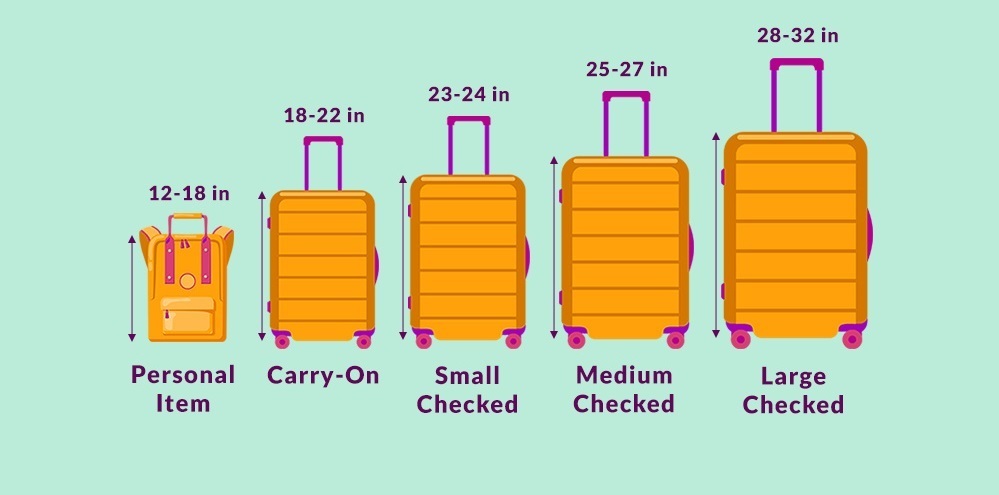
Suitcases can be categorized by size: S (53 x 36 x 24 cm); M (63 x 41 x 27 cm); L (70 x 47 x 30 cm); XL (80 x 54 x 33 cm);
Typically, a passenger car with a standard trunk can accommodate two large and one small suitcase, or two large and two small suitcases.
A van like the Renault Trafic or Mercedes V-Class can accommodate six to eight large suitcases and two to three small suitcases.
If you have more than 10 suitcases, you'll need two vans or a larger bus like the Mercedes Sprinter.

Some tourists don't have their own skis or snowboards; some don't like to carry them on long trips because they're more expensive to fly with and more difficult to transport. It's easier to rent them on the spot in the mountains.
However, many people prefer to ski exclusively on their own skis, as they're accustomed to them and their skis are the right level for them.
In this case, it's important to provide the operator with the exact number of skis and snowboards, as well as their length, when booking the transfer. It's also important to understand what kind of bags you'll be using for your equipment. The easiest way to fit soft, short covers in a car is (these can even be transported in a passenger car, especially one with a large trunk or if one of the rear seats is folded down). However, long, hard covers (especially those with wheels) can barely fit even in a van, and they're definitely impossible to transport in a sedan.
It is necessary to approach the issue of choosing a transfer car very responsibly and carefully. The comfort of your trip depends on this, and sometimes even the risk of not fitting into the car with all your luggage. The choice of car is carried out according to two parameters: the capacity of the car and its class.
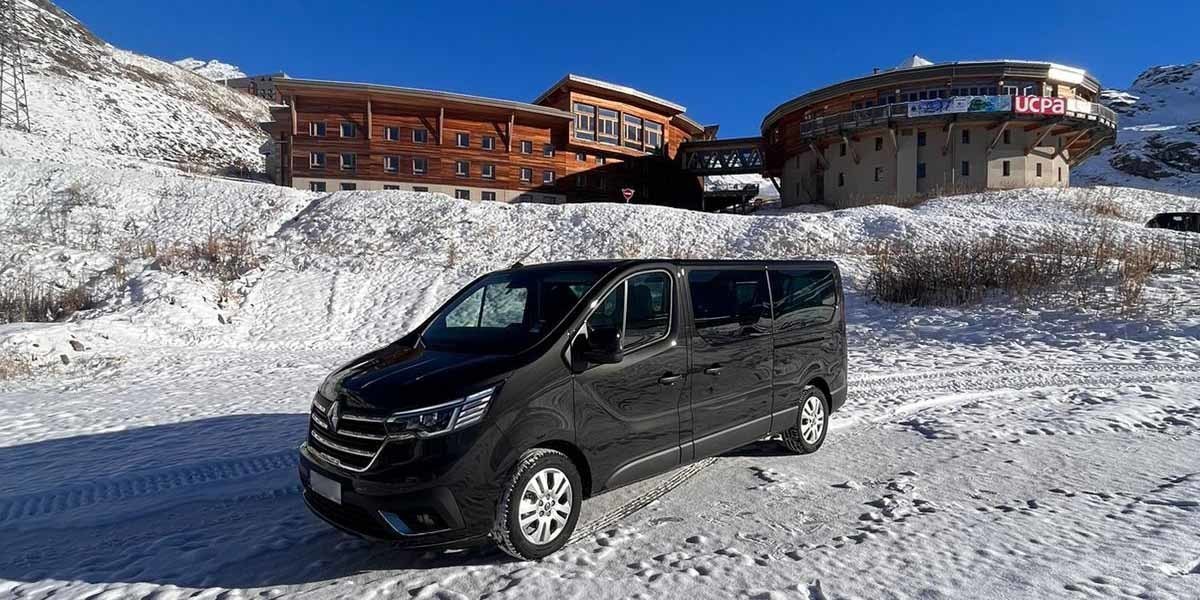
Winter transfers to ski resorts differ from summer ones in that they have a large amount of luggage, including non-standard sizes, so first of all, the passenger must be sure that they will fit in the car with all their belongings.
Small carlike a Volkswagen Jetta or Ford can accommodate 2-3 passengers, as well as 2 large suitcases and skis (they are placed in the rear seat back window or on the roof rack).
Passenger car with a large trunk such as a Volkswagen Passat SW or Skoda Jetta SW, or a BMW X5 or Kia Sorento crossover. They can carry 2-3 passengers (or sometimes 4 people); 3 large and 2 small suitcases, skis and a snowboard, especially if there is a special box for things on the roof.
Vans or minibuses such as Renault Trafic, Volkswagen Multivan, Mercedes V class are undoubtedly more suitable for transfers in the mountains. Thanks to the large luggage compartment, you don't have to worry about fitting all your many things. Even if you are a small group of people, you can travel long mountain distances, as you can lie down and relax on the seats. Vans accommodate groups of 2-8 passengers; you can carry 6-9 L suitcases, 4-6 skis; backpacks and boot bags. Of course, minibuses vary in the number of seats 6-8 and in the size of the trunk: Standard, Long and Extralong. Therefore, please list all your luggage to us in detail so that we can send you a car that meets your exact requirements.
Buses are designed for a large number of passengers: Mercedes Sprinter up to 20 pax and up to 20 suitcases; or large buses up to 50 pax and 50 suitcases. It is important to remember that at maximum seating (all 20 seats are occupied), the bus can only accommodate 1 large suitcase per passenger; for additional things and skis, you need to order a trailer or a second van, for example a Renault Trafic.
The comfort level of a car (its class) is the second main parameter for choosing a car.
Economy class: simple cars, small in size, with a small trunk and modest interior trim. Lowest transfer cost. Capacity 2-3 pax, with a small amount of luggage. Mazda 3; Skoda Oktavia, etc.
Comfort class: larger cars are presented that allow 2-4 passengers to travel; larger trunk size and much better quality of car interior materials, more comfortable seats. The price of the trip is approximately 20% higher than the economy one. Volkswagen Passat, Toyota Camry, Skoda Superb.
Business class: designed for more demanding passengers who value convenience and comfort. 2-3 passengers can comfortably travel in a business class sedan, while groups of 3-7 passengers usually travel in a business class van. The transfer price is 20-30% higher than Comfort. Cars Mercedes E class, BMW X5, Mercedes Vito.
Premium class: for connoisseurs of exquisite travel conditions. Very comfortable seats, plenty of space, the highest quality materials in the cabin. The transfer cost is high. Mercedes S class for 1-3 passengers. Mercedes V class for 2-7 passengers.
| Write to info@bycar.su | |
| Fill out the order form on the transfer page | |
| Send a message to WhatsApp |
| Experienced English-speaking drivers | |
| Meeting you with a sign displaying your name | |
| Fixed price | |
| No extra charge if your flight is delayed | |
| Road toll included | |
| Free child seats | |
| Wi-Fi | |
| 9 years of experience | |
| We work in 8 countries in Europe |
Fans of active winter recreation come to the resort of Courchevel not only from Lyon airport. Tourists can take routes from the airports of Geneva, Grenoble, Chambéry and Turin. In addition, Courchevel has a small airport for private flights.

from the airport of Geneva (GVA) - 167 km;
from Lyon airport (LYS) - 185 km;
from Chambery-Savoie Airport (CMF) – 106 km,
from Grenoble airport (St Geoirs - GNB) - 178 km,
from Turin Airport (Torino Caselle - TRN) - 248 km.
The most popular airport for travelers to Courchevel is Geneva. Thanks to a wider choice of flights. Lyon is the second most used airport. Tourists on a private jet often fly to Chambery airport. Charter flights arrive in Grenoble. Some travelers choose Turin Airport, not considering that it is located quite far from Courchevel and passes through a paid tunnel (this greatly increases the cost of the transfer).
Courchevel is the most prestigious and elite ski resort among the large-scale complex of the 3 Valleys. It is located in the heart of the French Alps. Millions of tourists from all over the world come here every season. Courchevel is distinguished by a wide variety of first-class slopes, recreation options for every taste, as well as a huge selection of hotels, restaurants, quality food and service.
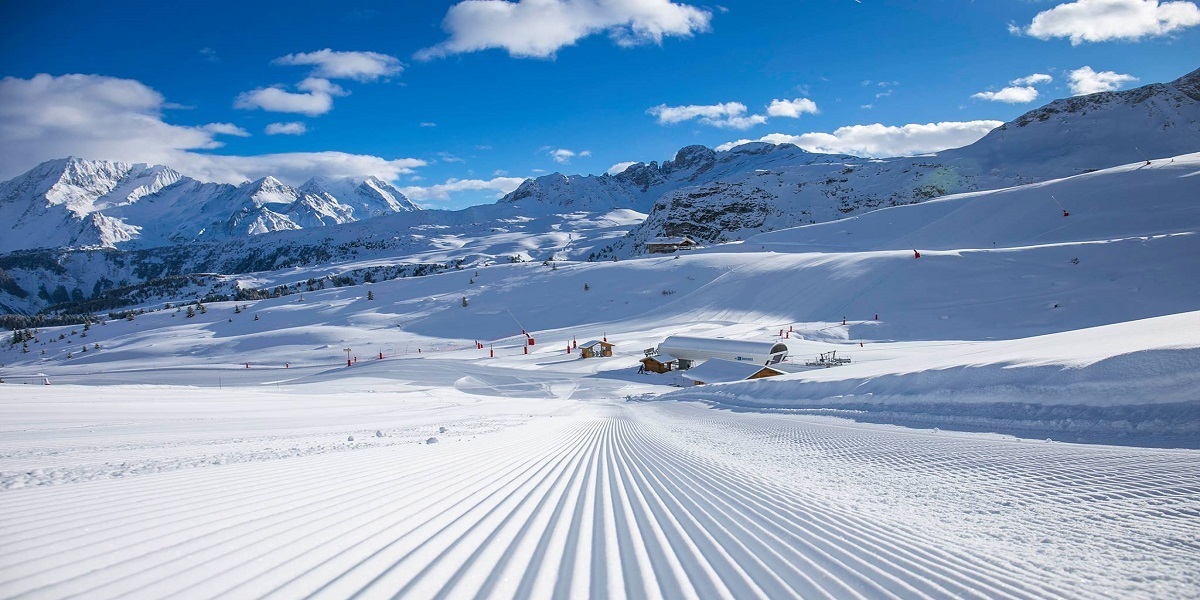
Courchevel has a mild and comfortable climate. In the middle of winter the temperature reaches only -10. Snow on the slopes of the French Alps lasts up to six months. February is the most popular month for travelers throughout the year. At this time, on the slopes, the thickness of the snow reaches its maximum mark.
Courchevel is surrounded by the dizzying landscapes of the Tarentaise Valley. The resort opened its first ski season in 1946. Today Courchevel has 102 pistes ranging from green to black. For novice winter sports enthusiasts, skiing in the Pralon and Bellecote zones is suitable. Trails of medium difficulty are located in the areas of Marmot, Bouc-Blanc, Cre, Grand Bus, Pyramids. For the pros, the black slopes of Les Aval, Grand Coulois and Col du Pas du Lac are ideal.
Courchevel is divided into four main stations, each of which is located at a different altitude and has its own unique features, atmosphere and level of accessibility. They differ not only in altitude, but also in the level of service, infrastructure, cost of accommodation and audience of vacationers.
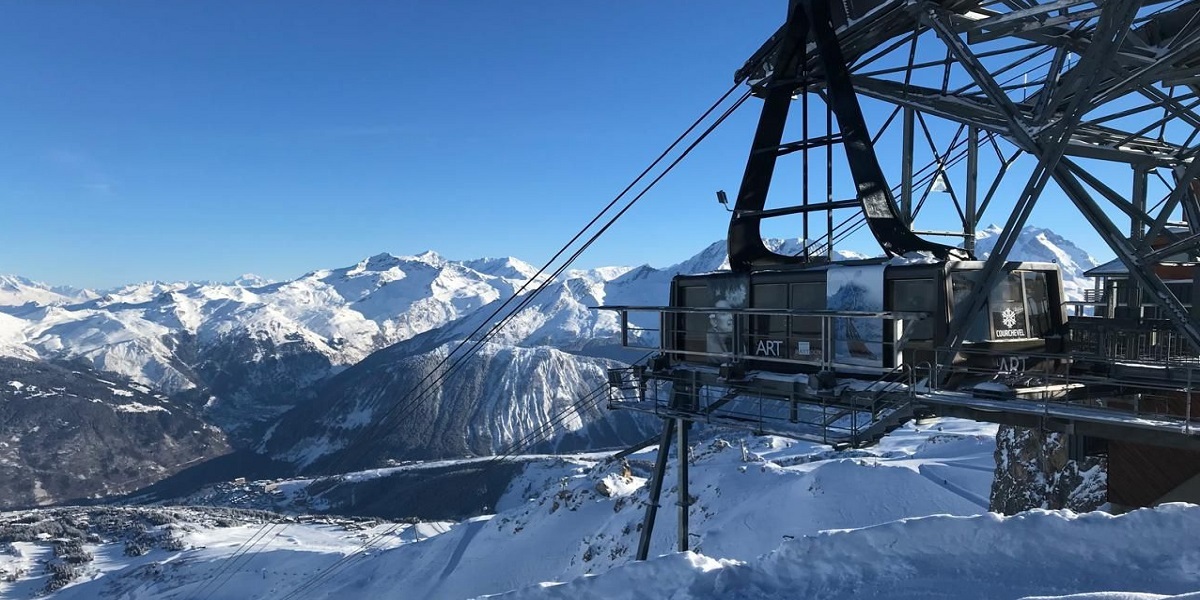
Courchevel 1300 (Le Praz):
Courchevel 1300 (or Le Praz) is the lowest level of the resort (1300 meters above sea level). Unlike the higher parts of Courchevel, Le Praz retains the authentic atmosphere of an alpine village. Here you can see traditional wooden chalets and narrow streets that create an atmosphere of antiquity and tranquility. Le Praz attracts those who prefer a more peaceful and measured holiday. Courchevel 1300 is popular with experienced skiers, as this area provides access to more difficult and long runs. Lifts from Le Praz allow easy access to the upper levels of the resort, as well as to the Three Valleys area. Accommodation here is more affordable than at other levels, making Le Praz a great choice for those looking to save on accommodation but still have access to the best slopes and infrastructure.
Courchevel 1550 (Courchevel Village):
Courchevel 1550, which is located at an altitude of 1550 meters, has a cozy and homely atmosphere. This level attracts skiers who are looking for more economical options for a holiday in Courchevel, but still want access to all the benefits of a large resort. Courchevel 1550 offers more affordable apartments and hotels oriented towards family holidays. The area is ideal for beginners and children, thanks to numerous easy runs and ski schools. However, due to the well-designed system of ski lifts, residents of this level can quickly and conveniently get to more difficult runs and take advantage of all the benefits of the resort. Accommodation here ranges from small family chalets to relatively budget hotels, making this level more democratic than Courchevel 1650 or 1850.
Courchevel 1650 (Courchevel Moriond):
Courchevel 1650 (or Moriond) is located at an altitude of 1650 meters and differs from Courchevel 1850 in its more relaxed and family-friendly atmosphere. This is the ideal place for those who want to enjoy skiing, but at the same time avoid the hustle and bustle of the higher levels of the resort. There is less luxury and pomp here, but the service is still at a high level. Courchevel 1650 is dominated by simpler and gentler slopes, which makes it popular with families with children and beginners. However, for more experienced skiers there are both red and black runs, and access to them is provided by a well-developed system of ski lifts. Accommodation here is significantly cheaper than in 1850, although still expensive compared to most other European resorts.
Courchevel 1850:
The most prestigious and expensive level is Courchevel 1850. This is a real "pearl" of the resort, located at an altitude of 1850 meters above sea level. Here are concentrated luxury chalets, five-star hotels and restaurants marked with Michelin stars. Courchevel 1850 is a place where the world elite gathers: celebrities, politicians, billionaires. This area has the largest selection of slopes for all levels of skiing, ranging from simple green for beginners to difficult black for experienced skiers. From here you can easily get to any point of the resort thanks to the modern lift system that serves the whole of Courchevel and connects it with the rest of the Three Valleys. It is at this level that holidaymakers most often enjoy not only sports activities, but also exclusive entertainment - be it private parties, shopping in luxury brand boutiques or dinners in elite restaurants. The cost of accommodation here is one of the highest in Europe and can reach tens of thousands of euros per night in luxury chalets with staff.
Thus, each level of Courchevel offers a unique holiday experience: Courchevel 1850 attracts with luxury and prestige, Courchevel 1650 - with a family atmosphere, Courchevel 1550 - with democracy and convenience, and Courchevel 1300 - with authenticity and tranquility. The choice of the station depends on the preferences and capabilities of the holidaymakers, but in any case, each level of Courchevel guarantees access to excellent ski slopes and a high level of service.
Undoubtedly, the fastest way to get from Lyon Airport to Courchevel is by helicopter, which takes no more than 50 minutes. However, this option has its drawbacks: firstly, flights can be canceled at any time due to bad weather, and secondly, this method of transportation costs around €3,000. For these reasons, tourists opt for a private car transfer, which takes an average of 3 - 3,5 hours, including traffic.
There is no train from Lyon Airport or from central Lyon to Courchevel. It only takes you part of the way to Moutiers. From there, you'll need to take a bus, taxi, or transfer along the winding road.
A taxi from Lyon Airport to Courchevel costs €480-690. The price from central Lyon is higher, approximately €550-760. The price is not known in advance; you'll only find out at the end of the trip, as it increases due to traffic jams, the amount of luggage and passengers, and is higher on weekends and holidays, as well as at night.
The best and most convenient way to get from Lyon Airport to Courchevel is a private transfer. The journey takes approximately 3 hours, and if your group consists of six people, you'll pay around €60 per person. For other options you will pay more or spend more time.
Courchevel is 178 km from Lyon Airport, which can be driven by car in 2.5 to 3.5 hours (depending on traffic). If you travel from the center of Lyon, the distance increases to 198 km, but the journey can take 1 hour longer during rush hour in Lyon.
Yes, you can take a bus from Lyon Airport to Courchevel, but there is no direct bus, you need to change in Moutiers.Total travel time is about 3.5 - 4.5 hours. The cost per person is approximately 70 euros. Bus transportation is provided by Altibus.
There are two cheapest options. The first is the bus, which costs 70€ per person. However, it's not very convenient because it's not a direct route to Courchevel. The cheapest option is to travel by private transfer in a group of 7 people on weekdays, then the price of a van will be 340€ / 7pax = 47€ per person.
Yes, the cost of a child seat is included in the transfer price from Lyon to Courchevel. However, you must inform us in advance when booking your transfer that you are traveling with a child and their age, so that the driver can select the appropriate type of seat and take them with him.
Yes, a transfer from Lyon to Courchevel can be booked online: contact our call center operator directly via WhatsApp, or submit your details on our website via the order form or email.
Our drivers monitor flight delays in the app. If the plane is not very late (within 1 hour) and if the driver does not have an upcoming transfer, he will wait for you. Otherwise, we will look for another of our cars or one of our partners for you so that you can get to your hotel in Courchevel.
Transportation of skis, snowboards and other sports equipment is included in the price of the transfer from Lyon to Courchevel. But you must tell us in advance their exact dimensions, types of covers and their quantity, so that we can select a suitable car that can accommodate all passengers and all things.
All our vehicles are equipped with winter tires and snow chains to handle winter mountain transfers, particularly from Lyon to Courchevel. We can also provide you with one of our all-wheel drive vehicles if you require it.
Philip
08.01.2025
This year we had a large group of friends and relatives, 18 adults and children. Everyone arrived at Lyon airport in the morning, but on different flights. We had more than 20 suitcases, I think 4 bags and 7 or 8 skis. To put it simply, a lot)) So we booked a bus for 19 people with a trailer in advance. I don’t think we would have fit in anything else. There was an option to go in three small vans, but we wanted to sit together in one car. Thank you for this wonderful opportunity and the patient driver))
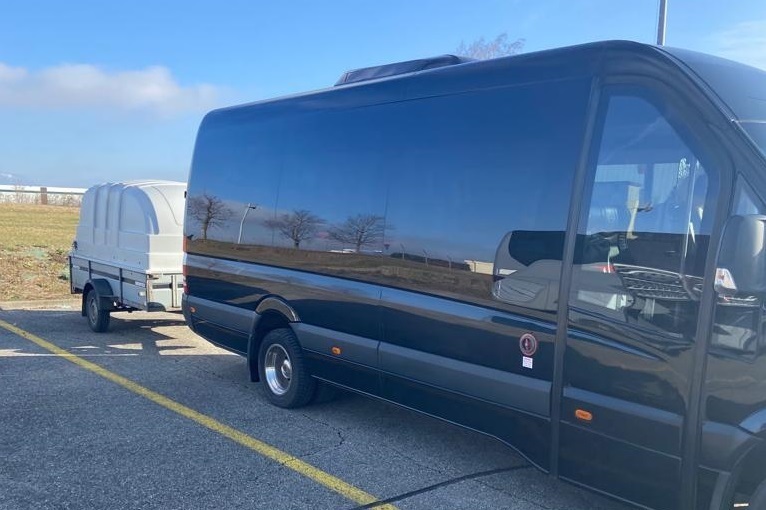
Anna
13.02.2025
I order a car for my boss on the Bycar website for the third time. He and his family are always happy. The drivers arrive on time and meet with a sign. The cars are always new and clean. We always book a V class van. The seats face each other, so it is not boring to sit and talk - the trip goes quickly. Next season we will definitely order a transfer from BYCAR.

Marcus
19.03.2025
I recommend this company to everyone. Last month we went skiing in Courchevel. We booked a car for the evening to Lyon airport. I really liked the driver, a good, kind guy. He drives very calmly. Thank you!
* You can send your feedback to our mail info@bycar.su